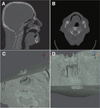This article has been
cited by other articles in ScienceCentral.
Abstract
This report is a case of 76-year old male patient who had difficulty in swallowing, pronunciation and suffered regurgitation of food. The patient lacks uvula and both tonsils, had short palatoglossal arch and soft palate, as well as defective left palatopharyngeal arch. The height and width of the soft palate defect were measured by reconstructing the Computed Tomography (CT) image in three dimensions. Phonation and soft palate obstructing ability were examined by nasometry and nasal endoscopy. Evaluations on phonetics and swallowing were done and improvements were shown. The patient was satisfied with the results of treatment.
Keywords: Palatopharyngeal insufficiency, Soft palate defect, Obturator, Edentulous jaw









 PDF
PDF ePub
ePub Citation
Citation Print
Print









 XML Download
XML Download